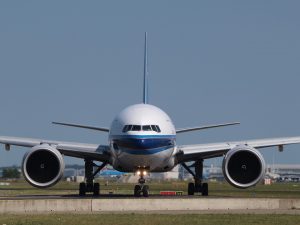 The Boeing 777 has become synonymous with commercial air travel. First taking off on June 12, 1994, the twin-engine jet is one of the most popular planes used by airlines. Boeing has sold thousands of 777s to airlines throughout the world, at an average cost of $320 million per unit — about $70 million more than Boeing’s 787-9. And while Boeing has no plans to stop manufacturing the 777, the aerospace manufacturing company’s first-ever 777 is landing for retirement at an Arizona museum.
The Boeing 777 has become synonymous with commercial air travel. First taking off on June 12, 1994, the twin-engine jet is one of the most popular planes used by airlines. Boeing has sold thousands of 777s to airlines throughout the world, at an average cost of $320 million per unit — about $70 million more than Boeing’s 787-9. And while Boeing has no plans to stop manufacturing the 777, the aerospace manufacturing company’s first-ever 777 is landing for retirement at an Arizona museum.
As previously mentioned, Boeing’s first 777 took off more than two decades ago. After performing test flights for several years, Boeing sold the twin-engine jet to Hong Kong airline Cathay Pacific. It was then used in countless commercial flights, fostering in a new era of commercial air travel. It appears its time has come to an end, however. Earlier this month, Boeing and Cathay Pacific announced plans to donate the first-ever 777 to the Pima Air & Space Museum in Arizona.
According to a report by CNN, the first-ever 777 performed more than 20,000 flights while in the Cathay Pacific’s operational fleet. In total, that calculates to almost 50,000 hours of flight time — a substantial number by any measurement. Here, aviation enthusiasts as well as the general public can marvel at Boeing’s accomplishment.
When speaking about the first-ever 777’s retirement, Kevin McAllister explained that Cathay Pacific was “instrumental” in the twin-engine jet’s success. Among other things, the airline provided feedback to Boeing on how to improve and optimize the 777’s design.
“Cathay Pacific has been instrumental in the tremendous success of the 777 program. The airline contributed greatly to the airplane’s original design and has been one of its biggest ambassadors ever since. And now they are a launch customer for our new 777X airplane. We are thrilled to partner with Cathay on this donation to the museum as a way to share the remarkable story of the Boeing 777 for years come,” said Boeing Commercial Airplanes President and CEO Kevin McAllister in a press release announcing Cathay Pacific’s retirement.
When it was first launched, the 777 was Boeing’s second-most profitable jet, surpassed only by the 747. It wasn’t until the 2000s when Boeing released an updated the version of the 777 that it become the company’s most profitable jet.
Although the first-ever 777 is lying down for a final nap at the Air & Space Museum in Arizona, Boeing will continue to build the twin-engine jet. The company currently builds around five 777s per month, compared to about seven per month in 2017.



